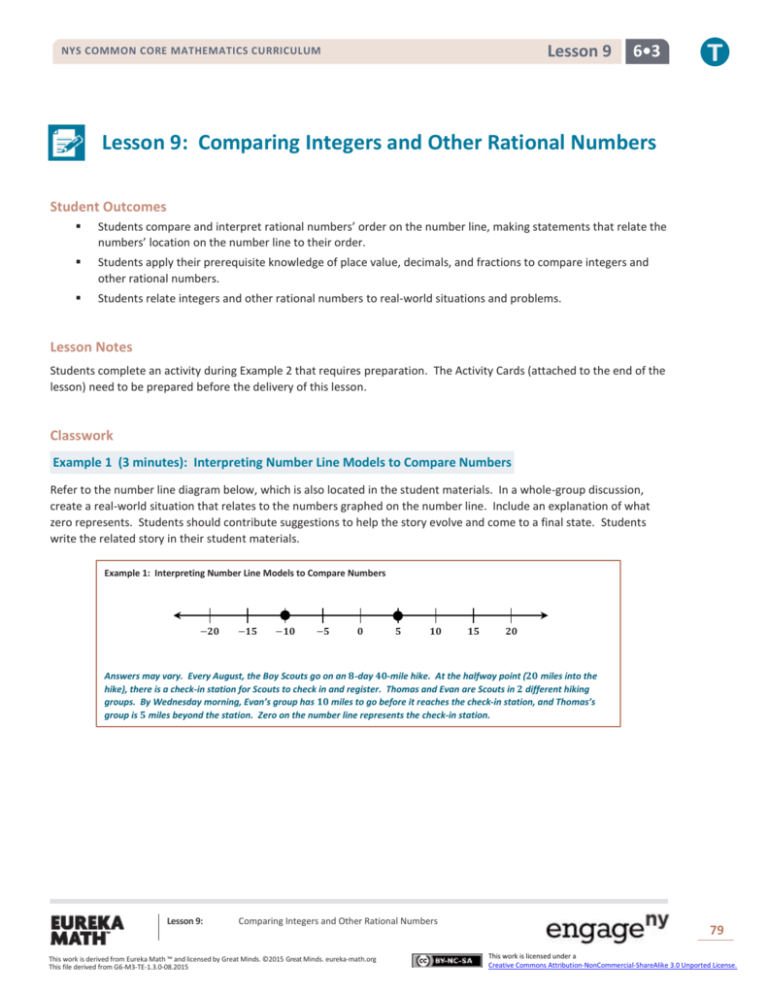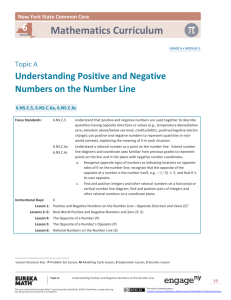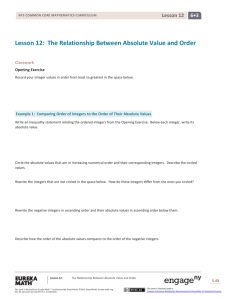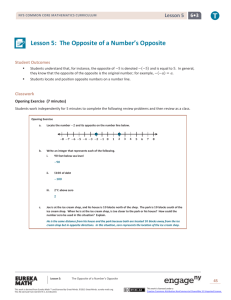Lesson 9: Comparing Integers and Other Rational
advertisement

Lesson 9 NYS COMMON CORE MATHEMATICS CURRICULUM 6•3 Lesson 9: Comparing Integers and Other Rational Numbers Student Outcomes Students compare and interpret rational numbers’ order on the number line, making statements that relate the numbers’ location on the number line to their order. Students apply their prerequisite knowledge of place value, decimals, and fractions to compare integers and other rational numbers. Students relate integers and other rational numbers to real-world situations and problems. Lesson Notes Students complete an activity during Example 2 that requires preparation. The Activity Cards (attached to the end of the lesson) need to be prepared before the delivery of this lesson. Classwork Example 1 (3 minutes): Interpreting Number Line Models to Compare Numbers Refer to the number line diagram below, which is also located in the student materials. In a whole-group discussion, create a real-world situation that relates to the numbers graphed on the number line. Include an explanation of what zero represents. Students should contribute suggestions to help the story evolve and come to a final state. Students write the related story in their student materials. Example 1: Interpreting Number Line Models to Compare Numbers −𝟐𝟎 −𝟏𝟓 −𝟏𝟎 −𝟓 𝟎 𝟓 𝟏𝟎 𝟏𝟓 𝟐𝟎 Answers may vary. Every August, the Boy Scouts go on an 𝟖-day 𝟒𝟎-mile hike. At the halfway point (𝟐𝟎 miles into the hike), there is a check-in station for Scouts to check in and register. Thomas and Evan are Scouts in 𝟐 different hiking groups. By Wednesday morning, Evan’s group has 𝟏𝟎 miles to go before it reaches the check-in station, and Thomas’s group is 𝟓 miles beyond the station. Zero on the number line represents the check-in station. Lesson 9: Comparing Integers and Other Rational Numbers This work is derived from Eureka Math ™ and licensed by Great Minds. ©2015 Great Minds. eureka-math.org This file derived from G6-M3-TE-1.3.0-08.2015 79 This work is licensed under a Creative Commons Attribution-NonCommercial-ShareAlike 3.0 Unported License. Lesson 9 NYS COMMON CORE MATHEMATICS CURRICULUM 6•3 Exercise 1 (7 minutes) Display the following vertical number line model on the board. Students are to independently interpret the number line model to describe a real-world situation involving these two rational numbers. Remind students to compare the numbers and describe their order in their write-ups. After allowing adequate time for students to write their solutions, several students share what they wrote with the class. Students in the class determine whether the written responses correctly relate to the number line models. Scaffolding: Provide a story starter for students who are struggling to begin the writing task. Exercise 1 1. Create a real-world situation that relates to the points shown in the number line model. Be sure to describe the relationship between the values of the two points and how it relates to their order on the number line. Answers will vary. Alvin lives in Canada and is recording the outside temperature each night before he goes to bed. On Monday night, he recorded a temperature of 𝟎 degrees Celsius. On Tuesday night, he recorded a temperature of −𝟏 degree Celsius. Tuesday night’s temperature was colder than Monday night’s temperature. −𝟏 is less than 𝟎, so the associated point is below 𝟎 on a vertical number line. 𝟎 −𝟏 Example 2 (10 minutes) Students are seated in groups of three or four, and each group is given a set of Activity Cards. For each group, photocopy, cut out, and scramble both sheets of Activity Cards that appear at the end of this lesson. Each group of students matches each word story card to its related number line card. For each number line diagram, students must write a statement relating the numbers’ placement on the number line to their order. If time permits, the class goes over each answer as a whole group. For each number line diagram, students present their written statements as verbal statements to the class. An example follows: The Navy Seals are practicing new techniques. The blue submarine is 450 ft. below sea level, while the red submarine is 375 ft. below sea level. −𝟓𝟎𝟎 −𝟒𝟎𝟎 −𝟑𝟎𝟎 −𝟐𝟎𝟎 −𝟏𝟎𝟎 𝟎 The blue submarine is farther below sea level than the red submarine because −450 is to the left of −375 on the number line; it is less than −375. Lesson 9: Comparing Integers and Other Rational Numbers This work is derived from Eureka Math ™ and licensed by Great Minds. ©2015 Great Minds. eureka-math.org This file derived from G6-M3-TE-1.3.0-08.2015 80 This work is licensed under a Creative Commons Attribution-NonCommercial-ShareAlike 3.0 Unported License. Lesson 9 NYS COMMON CORE MATHEMATICS CURRICULUM 6•3 Exercises 2–8 (15 minutes) Students read each of the following scenarios and decide whether they agree or disagree. They must defend and explain their stance in writing. Allow time for students to share their answers with the class and explain their reasoning. The class should come to a consensus for each one. Exercises 2–8 Scaffolding: Provide a set of horizontal and vertical number lines for visual learners to create a number line model for each exercise. For each problem, determine if you agree or disagree with the representation. Then, defend your stance by citing specific details in your writing. 2. 𝟏 𝟐 Felicia needs to write a story problem that relates to the order in which the numbers −𝟔 and −𝟏𝟎 are represented on a number line. She writes the following: 𝟏 𝟐 “During a recent football game, our team lost yards on two consecutive downs. We lost 𝟔 yards on the first down. During the second down, our quarterback was sacked for an additional 𝟏𝟎-yard loss. On the number line, I 𝟏 𝟐 𝟏 𝟐 represented this situation by first locating −𝟔 . I located the point by moving 𝟔 units to the left of zero. Then, I graphed the second point by moving 𝟏𝟎 units to the left of 𝟎.” 𝟏 𝟐 𝟏 𝟐 Agree. −𝟏𝟎 is less than −𝟔 since −𝟏𝟎 is to the left of −𝟔 on the number line. Since both numbers are negative, they indicate the team lost yards on both football plays, but they lost more yards on the second play. 3. MP.2 & MP.3 𝟑 𝟒 𝟏 𝟐 Manuel looks at a number line diagram that has the points − and − graphed. He writes the following related story: “I borrowed 𝟓𝟎 cents from my friend, Lester. I borrowed 𝟕𝟓 cents from my friend, Calvin. I owe Lester less than I owe Calvin.” 𝟑 𝟒 𝟏 𝟐 Agree. − is equivalent to −𝟎. 𝟕𝟓 and − is equivalent to −𝟎. 𝟓𝟎. −𝟎. 𝟓𝟎 and −𝟎. 𝟕𝟓 both show that he owes money. But −𝟎. 𝟓𝟎 is farther to the right on a number line, so Manuel does not owe Lester as much as he owes Calvin. 4. 𝟏 𝟒 Henry located 𝟐 and 𝟐. 𝟏 on a number line. He wrote the following related story: 𝟏 𝟒 “In gym class, both Jerry and I ran for 𝟐𝟎 minutes. Jerry ran 𝟐 miles, and I ran 𝟐. 𝟏 miles. I ran a farther distance.” 𝟏 𝟒 𝟏 𝟒 Disagree. 𝟐 is greater than 𝟐. 𝟏 since 𝟐 is equivalent to 𝟐. 𝟐𝟓. On the number line, the point associated with 𝟐. 𝟐𝟓 is to the right of 𝟐. 𝟏. Jerry ran a farther distance. 5. Sam looked at two points that were graphed on a vertical number line. He saw the points −𝟐 and 𝟏. 𝟓. He wrote the following description: “I am looking at a vertical number line that shows the location of two specific points. The first point is a negative number, so it is below zero. The second point is a positive number, so it is above zero. The negative number is −𝟐. The positive number is 𝟏 𝟐 unit more than the negative number.” Disagree. Sam was right when he said the negative number is below zero and the positive number is above zero. 𝟏 𝟐 But 𝟏. 𝟓 is 𝟏 units above zero, and −𝟐 is 𝟐 units below zero. So, altogether, that means the positive number is 𝟑 𝟏 𝟐 units more than −𝟐. Lesson 9: Comparing Integers and Other Rational Numbers This work is derived from Eureka Math ™ and licensed by Great Minds. ©2015 Great Minds. eureka-math.org This file derived from G6-M3-TE-1.3.0-08.2015 81 This work is licensed under a Creative Commons Attribution-NonCommercial-ShareAlike 3.0 Unported License. Lesson 9 NYS COMMON CORE MATHEMATICS CURRICULUM 6•3 Claire draws a vertical number line diagram and graphs two points: −𝟏𝟎 and 𝟏𝟎. She writes the following related story: 6. “These two locations represent different elevations. One location is 𝟏𝟎 feet above sea level, and one location is 𝟏𝟎 feet below sea level. On a number line, 𝟏𝟎 feet above sea level is represented by graphing a point at 𝟏𝟎, and 𝟏𝟎 feet below sea level is represented by graphing a point at −𝟏𝟎.” Agree. Zero in this case represents sea level. Both locations are 𝟏𝟎 feet from zero but in opposite directions, so they are graphed on the number line at 𝟏𝟎 and −𝟏𝟎. 7. Mrs. Kimble, the sixth-grade math teacher, asked the class to describe the relationship between two points on the number line, 𝟕. 𝟒𝟓 and 𝟕. 𝟓, and to create a real-world scenario. Jackson writes the following story: “Two friends, Jackie and Jennie, each brought money to the fair. Jackie brought more than Jennie. Jackie brought $𝟕. 𝟒𝟓, and Jennie brought $𝟕. 𝟓𝟎. Since 𝟕. 𝟒𝟓 has more digits than 𝟕. 𝟓, it would come after 𝟕. 𝟓 on the number line, or to the right, so it is a greater value.” Disagree. Jackson is wrong by saying that 𝟕. 𝟒𝟓 is to the right of 𝟕. 𝟓 on the number line. 𝟕. 𝟓 is the same as 𝟕. 𝟓𝟎, and it is greater than 𝟕. 𝟒𝟓. When I count by hundredths starting at 𝟕. 𝟒𝟓, I would say 𝟕. 𝟒𝟔, 𝟕. 𝟒𝟕, 𝟕. 𝟒𝟖, 𝟕. 𝟒𝟗, and then 𝟕. 𝟓𝟎. So, 𝟕. 𝟓𝟎 is greater than 𝟕. 𝟒𝟓, and the associated point falls to the right of the point associated with 𝟕. 𝟒𝟓 on the number line. MP.2 & MP.3 𝟏 𝟒 𝟏 𝟐 Justine graphs the points associated with the following numbers on a vertical number line: −𝟏 , −𝟏 , and 𝟏. She 8. then writes the following real-world scenario: “The nurse measured the height of three sixth-grade students and compared their heights to the height of a typical sixth grader. Two of the students’ heights are below the typical height, and one is above the typical height. The point whose coordinate is 𝟏 represents the student who has a height that is 𝟏 inch above the typical height. Given 𝟏 𝟒 this information, Justine determined that the student represented by the point associated with −𝟏 is the shortest of the three students.” 𝟏 𝟒 Disagree. Justine was wrong when she said the point −𝟏 represents the shortest of the three students. If zero 𝟏 𝟐 stands for no change from the typical height, then the point associated with −𝟏 is farther below zero than the 𝟏 𝟒 point associated with −𝟏 . The greatest value is positive 𝟏. Positive 𝟏 represents the tallest person. The shortest 𝟏 𝟐 person is represented by −𝟏 . Closing (4 minutes) How can use you use the number line to order a set of numbers? Will graphing the numbers on a vertical number line rather than a horizontal number line change this process? You can locate and graph the numbers on the number line to determine their order. If you use a vertical number line, their order is the same as it is on a horizontal number line, but instead of moving from left to right to go from least to greatest, you move from bottom to top. To determine the order of a set of numbers, the number that is farthest left (or farthest down on a vertical number line) is the smallest value. As you move right (or toward the top on a vertical number line), the numbers increase in value. So, the greatest number is graphed farthest right on a number line (or the highest one on a vertical number line). If two points are graphed on a number line, what can you say about the value of the number associated with the point on the right in comparison to the value of the number associated with the point on the left? The number associated with the point on the right is greater than the number associated with the point on the left. Lesson 9: Comparing Integers and Other Rational Numbers This work is derived from Eureka Math ™ and licensed by Great Minds. ©2015 Great Minds. eureka-math.org This file derived from G6-M3-TE-1.3.0-08.2015 82 This work is licensed under a Creative Commons Attribution-NonCommercial-ShareAlike 3.0 Unported License. NYS COMMON CORE MATHEMATICS CURRICULUM Lesson 9 6•3 1 2 Which number is larger: −3.4 or −3 ? How will graphing these numbers on a number line help you make this determination? Whichever number is graphed farthest to the left (or below) is the smaller number. In this example, 1 2 −3 would be graphed to the left of −3.4, so it is the smaller number. You can compare the numbers to make sure they are graphed correctly by either representing them both as a decimal or both as a 1 2 fraction. −3 is halfway between −3 and −4. So, if I divide the space into tenths, the associated point 1 2 5 . When I graph −3.4, it would be 0.1 closer to −3, so it would be 10 1 1 to the right of −3 . This means −3.4 is larger than −3 . 2 2 would be at −3.5 since −3 = −3 Exit Ticket (6 minutes) Lesson 9: Comparing Integers and Other Rational Numbers This work is derived from Eureka Math ™ and licensed by Great Minds. ©2015 Great Minds. eureka-math.org This file derived from G6-M3-TE-1.3.0-08.2015 83 This work is licensed under a Creative Commons Attribution-NonCommercial-ShareAlike 3.0 Unported License. Lesson 9 NYS COMMON CORE MATHEMATICS CURRICULUM Name 6•3 Date Lesson 9: Comparing Integers and Other Rational Numbers Exit Ticket 1. Interpret the number line diagram shown below, and write a statement about the temperature for Tuesday compared to Monday at 11:00 p.m. 50 Monday’s Temperature (°F) at 11:00 p.m. 0 Tuesday’s Temperature (°F) at 11:00 p.m. −50 2. If the temperature at 11:00 p.m. on Wednesday is warmer than Tuesday’s temperature but still below zero, what is a possible value for the temperature at 11:00 p.m. Wednesday? Lesson 9: Comparing Integers and Other Rational Numbers This work is derived from Eureka Math ™ and licensed by Great Minds. ©2015 Great Minds. eureka-math.org This file derived from G6-M3-TE-1.3.0-08.2015 84 This work is licensed under a Creative Commons Attribution-NonCommercial-ShareAlike 3.0 Unported License. Lesson 9 NYS COMMON CORE MATHEMATICS CURRICULUM 6•3 Exit Ticket Sample Solutions 1. Interpret the number line diagram shown below, and write a statement about the temperature for Tuesday compared to Monday at 11:00 p.m. 𝟓𝟎 Monday’s Temperature (°𝐅) at 11:00 p.m. 𝟎 Tuesday’s Temperature (°𝐅) at 11:00 p.m. At 11:00 p.m. on Monday, the temperature was about 𝟒𝟎 degrees Fahrenheit, but at 11:00 p.m. on Tuesday, it was −𝟏𝟎 degrees Fahrenheit. Tuesday’s temperature of −𝟏𝟎 degrees is below zero, but 𝟒𝟎 degrees is above zero. It was much warmer on Monday at 11:00 p.m. than on Tuesday at that time. −𝟓𝟎 2. If the temperature at 11:00 p.m. on Wednesday is warmer than Tuesday’s temperature but still below zero, what is a possible value for the temperature at 11:00 p.m. Wednesday? Answers will vary but must be between 𝟎 and −𝟏𝟎. A possible temperature for Wednesday at 11:00 p.m. is −𝟑 degrees Fahrenheit because −𝟑 is less than zero and greater than −𝟏𝟎. Problem Set Sample Solutions Write a story related to the points shown in each graph. Be sure to include a statement relating the numbers graphed on the number line to their order. 1. Answers will vary. Marcy earned no bonus points on her first math quiz. She earned 𝟒 bonus points on her second math quiz. Zero represents earning no bonus points, and 𝟒 represents earning 𝟒 bonus points. Zero is graphed to the left of 𝟒 on the number line. Zero is less than 𝟒. 2. Answers will vary. My uncle’s investment lost $𝟐𝟎𝟎 in May. In June, the investment gained $𝟏𝟓𝟎. The situation is represented by the points −𝟐𝟎𝟎 and 𝟏𝟓𝟎 on the vertical number line. Negative 𝟐𝟎𝟎 is below zero, and 𝟏𝟓𝟎 is above zero. −𝟐𝟎𝟎 is less than 𝟏𝟓𝟎. Lesson 9: Comparing Integers and Other Rational Numbers This work is derived from Eureka Math ™ and licensed by Great Minds. ©2015 Great Minds. eureka-math.org This file derived from G6-M3-TE-1.3.0-08.2015 85 This work is licensed under a Creative Commons Attribution-NonCommercial-ShareAlike 3.0 Unported License. Lesson 9 NYS COMMON CORE MATHEMATICS CURRICULUM 6•3 3. Answers will vary. I gave my sister $𝟏. 𝟓𝟎 last week. This week, I gave her $𝟎. 𝟓𝟎. The points −𝟏. 𝟓𝟎 and −𝟎. 𝟓𝟎 represent the change to my money supply. We know that −𝟏. 𝟓𝟎 is to the left of −𝟎. 𝟓𝟎 on the number line; therefore, −𝟎. 𝟓𝟎 is greater than −𝟏. 𝟓𝟎. 4. Answers will vary. A fish is swimming 𝟕 feet below the water’s surface. A turtle is swimming 𝟐 feet below the water’s surface. We know that −𝟕 is to the left of −𝟐 on the number line. This means −𝟕 is less than −𝟐. 5. Answers will vary. I spent $𝟖 on a CD last month. I earned $𝟓 in allowance last month. −𝟖 and 𝟓 represent the changes to my money last month. −𝟖 is to the left of 𝟓 on a number line. −𝟖 is 𝟑 units farther away from zero than 𝟓, which means that I spent $𝟑 more on the CD than I made in allowance. 6. Answers will vary. Skip, Mark, and Angelo were standing in line in gym class. Skip was the third person behind Mark. Angelo was the first person ahead of Mark. If Mark represents zero on the number line, then Skip is associated with the point at −𝟑, and Angelo is associated with the point at 𝟏. 𝟏 is 𝟏 unit to the right of zero, and −𝟑 is 𝟑 units to the left of zero. −𝟑 is less than 𝟏. 7. Answers will vary. I rode my bike line, 𝟑 𝟓 and 𝟒 𝟓 𝟑 𝟓 miles on Saturday and 𝟒 𝟓 are both associated with points above zero, but 𝟑 miles on Sunday. On a vertical number 𝟒 𝟓 𝟑 𝟒 𝟓 𝟓 is above . This means that is greater than . 𝟓 Lesson 9: Comparing Integers and Other Rational Numbers This work is derived from Eureka Math ™ and licensed by Great Minds. ©2015 Great Minds. eureka-math.org This file derived from G6-M3-TE-1.3.0-08.2015 86 This work is licensed under a Creative Commons Attribution-NonCommercial-ShareAlike 3.0 Unported License. 6•3 Lesson 9 NYS COMMON CORE MATHEMATICS CURRICULUM Activity Cards—Page 1 The Navy Seals are practicing new techniques. The blue submarine is 450 ft. below sea level, while the red submarine is 375 ft. below sea level. Colorado is known for drastic changes in temperatures. Tuesday morning the temperature was 32°F, but Tuesday night the temperature was −3°F. Holly sold lemonade two days in a row. On Saturday, Holly earned $5.75. On Sunday, Holly earned $3.25. −𝟓𝟎𝟎 −𝟒𝟎𝟎 −𝟑𝟎𝟎 −𝟐𝟎𝟎 −𝟏𝟎𝟎 −𝟒 −𝟐 −𝟏 Lesson 9: 𝟎 𝟒 𝟖 𝟎 𝟏 Dolphins love to jump out of the water. Dolly, the dolphin, can jump 5 meters above the water and swim 450 meters below the surface of the water. 𝟎 𝟏𝟐 𝟏𝟔 𝟐𝟎 𝟐𝟒 𝟐𝟖 𝟑𝟐 𝟐 𝟑 𝟒 𝟓 𝟔 𝟕 𝟖 The high school football team lost 8 yards on first down. On second down, the team gained 2 yards. In golf, the lowest score wins. Pete’s final score was −2, and Andre’s final score was −5. Comparing Integers and Other Rational Numbers This work is derived from Eureka Math ™ and licensed by Great Minds. ©2015 Great Minds. eureka-math.org This file derived from G6-M3-TE-1.3.0-08.2015 −𝟒𝟎𝟎 −𝟑𝟎𝟎 −𝟐𝟎𝟎 −𝟏𝟎𝟎 −𝟖 −𝟕 𝟎 −𝟔 −𝟒 −𝟐 𝟎 𝟐 −𝟓 −𝟑 −𝟏 𝟎 𝟏 𝟑 87 This work is licensed under a Creative Commons Attribution-NonCommercial-ShareAlike 3.0 Unported License. Lesson 9 NYS COMMON CORE MATHEMATICS CURRICULUM 6•3 Activity Cards—Page 2 Teagon earned $450 last month cutting grass. Xavier spent $375 on a new computer. Kim and her friend Stacey went to the bookstore. Stacey spent $8 on notebooks. Kim spent $5 on snacks and pencils. At a beach in California, if a person stands in the water, he is 1 5 ft. below sea level. If the person walks onto the beach, he is 2 5 ft. above sea level. Lesson 9: Jayden has earned 3 bonus points completing math extra credit assignments, while Shontelle has earned 32 bonus points. Last month, the stock market 3 dropped 5 points overall. So 4 far this month, the stock 1 4 market rose 3 points. Brittany went to an office supply store twice last week. The first time, she made 2 copies that cost $0.20 each. The second time, she did not buy anything but found 2 dimes in the parking lot. Comparing Integers and Other Rational Numbers This work is derived from Eureka Math ™ and licensed by Great Minds. ©2015 Great Minds. eureka-math.org This file derived from G6-M3-TE-1.3.0-08.2015 88 This work is licensed under a Creative Commons Attribution-NonCommercial-ShareAlike 3.0 Unported License.









